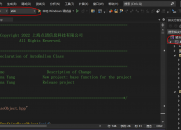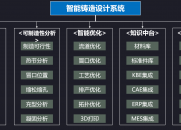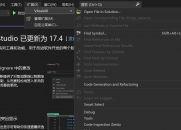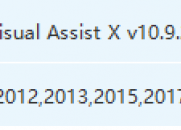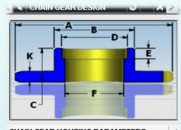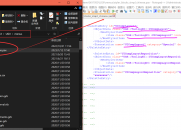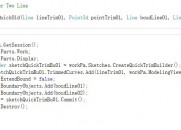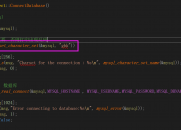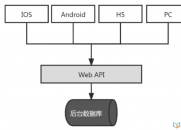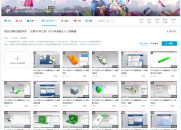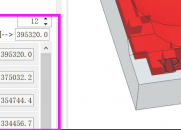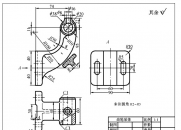请使用QQ关联注册PLM之家,学习更多关于内容,更多精彩原创视频供你学习!
您需要 登录 才可以下载或查看,没有账号?注册

x
The examples show how to access the following relationships: ! H! b! A2 c& Z4 N5 j
NX session → list of parts part → list of solid bodies solid body → list of faces solid body → list of edges face → list of associated edges face → solid body edge → list of associated faces edge → solid body 8 z3 K' \; H5 L0 _4 W U% s7 ~
, F$ B- i; s6 e5 FBodies, Faces and Edges - Language Specific Details2 _6 G _( Y' h' u; r6 C
NX Open for C++ NX Open for .NET NX Open for Java _8 _" z" D- b W; j
a' n, t6 M0 Q: u, v
NX Open for C++
9 p; Y+ z( G1 u( C* v W
$ g. Z0 Z4 U# l
0 h2 w# t8 `1 ?: |! g1 S6 c1 _NX session → list of parts4 O4 m& t9 i! L
To access all parts in an NX session, use the Parts property to access the Part Collection. Then use the collection's iterator to access each part. Session *NXSession = Session::GetSession(); ParTCollection *partList = NXSession->Parts(); PartCollection::iterator itr; for ( itr = partList->begin(); itr != partList->end(); ++itr ) { processPart(*itr); }* B- [3 V0 M! T4 R2 Y0 w
! p0 U7 A/ \; lpart → list of solid bodies
+ B/ D4 X$ T. F y: g4 ~; p# STo access all solid bodies in a part, use the Bodies property to access the Body Collection. Then use the collection's iterator to access each body. void processPart(Part *partObject){ BodyCollection *bodyList = partObject->Bodies(); BodyCollection::iterator itr; for (itr = bodyList->begin(); itr != bodyList->end(); ++itr) { processBodyFaces(*itr); processBodyEdges(*itr); }}# w1 E( t9 L+ p" e% X% G! L
) Q. k' r# c! ] \: o3 O) F
solid body → list of faces
! I" _7 }1 U: Z: @9 D4 I% C, h& H1 `To access the faces of a body use the GetFaces() method to return an array of faces. void processBodyEdges(Body *bodyObject){ std::vector <Edge *> edgeArray = bodyObject->GetEdges(); for (int inx = 0; inx < (int)edgeArray.size(); ++inx) { processEdge(edgeArray[inx]); }} $ O( D7 k- P, i$ ^4 _& T
) y2 V! u: w, n- m4 B3 {2 xsolid body → list of edges$ t9 t: D" b0 }, m$ R5 R. |
To access the edges in a body use the GetEdges() method to return an array of edges. void processBodyEdges(Body *bodyObject){ std::vector <Edge *> edgeArray = bodyObject->GetEdges(); for (int inx = 0; inx < (int)edgeArray.size(); ++inx) { processEdge(edgeArray[inx]); }} # o1 }* K% F& Q/ `
3 @" m" }+ u' a' J/ T
face → list of associated edges
7 h9 j, V. v2 W, b7 A$ yface → solid body/ M& ?$ s! D, N" ?: `/ m( u" D
To access the edges for a face use the GetEdges() method to return an array of edges. To access the face's body use the GetBody() method. void processFace(Face *faceObject){ std::vector<Edge *> edgeArray = faceObject->GetEdges(); for (int inx = 0; inx < (int)edgeArray.size(); ++inx) { processEdge(edgeArray[inx]); } Body *bodyOfFace = faceObject->GetBody();}
1 ~$ ]6 V1 F# R0 a, ^3 [+ @6 Y# u8 F; Q1 p- s! }$ n
edge → list of associated faces6 R; Z) a& c1 a" m7 ~
edge → solid body* c3 [# P1 p$ `# B: L9 D
To access the faces associated with and edge use the GetFaces() method to return an array of faces. To access the edge's body use the GetBody() method. void processEdge(Edge *edgeObject){ std::vector<Face *> faceArray = edgeObject->GetFaces(); for (int inx = 0; inx < (int)faceArray.size(); ++inx) { processEdgeFace(faceArray[inx]); } Body *bodyOfEdge = edgeObject->GetBody();}) B7 X, Q1 K2 G! s& W K& M& F4 m
| 

